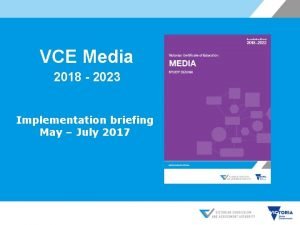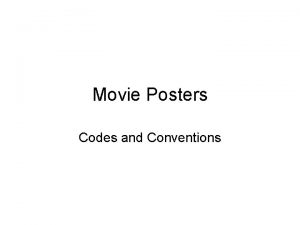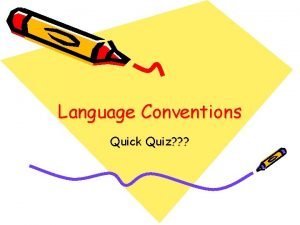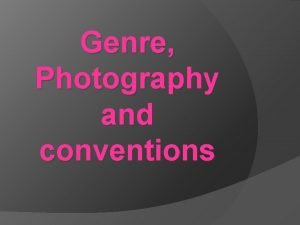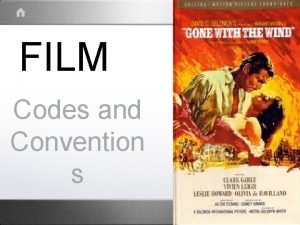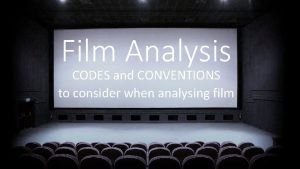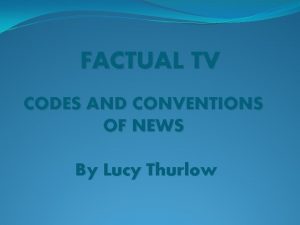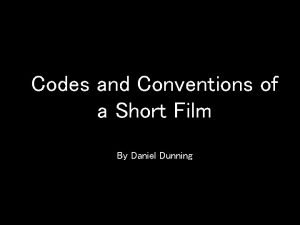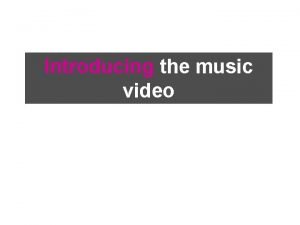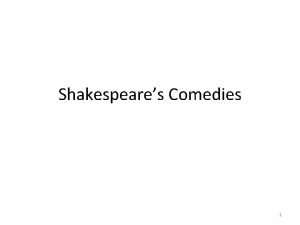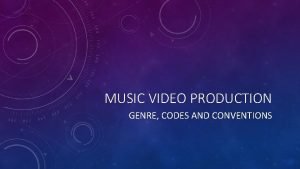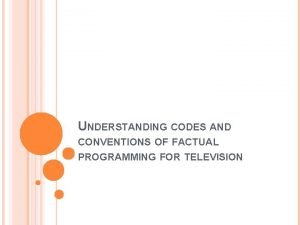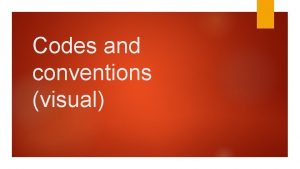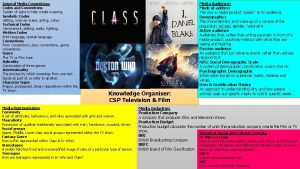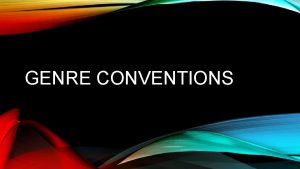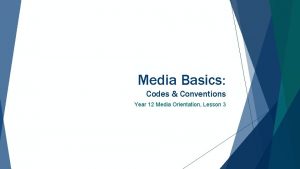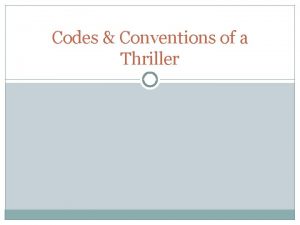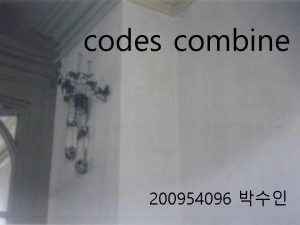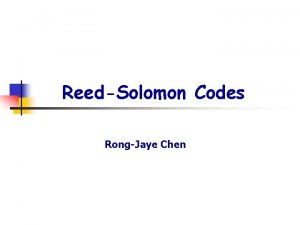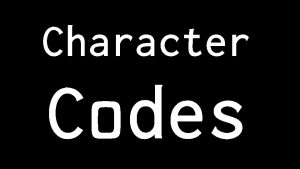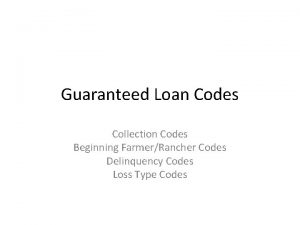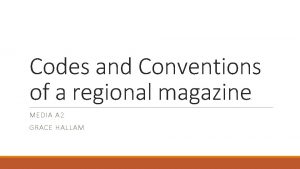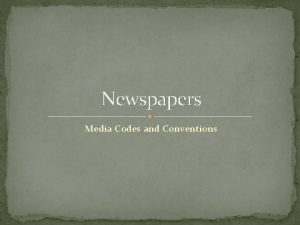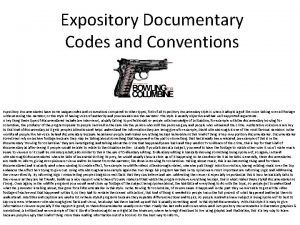Codes and conventions Part I Media Have Conventions















- Slides: 15

Codes and conventions Part I: Media Have Conventions Part II: Information/Digital Literacy and Media Literacy Essential Question: What type of “text” is it? How do the various texts and elements shape the meaning? What techniques are being used to attract our attention? Sources: http: //www. ci. appstate. edu/programs/edmedia/medialit/ml_adolescents 2. html http: //cehd. ewu. edu/faculty/ntodd/EDUC 538 Julie. html

Codes and conventions Overview of Concepts Covered Ø Media have distinct characteristics and languages Ø Each Medium also has distinct characteristics and languages Ø Form and content together are used to create desired impressions and effects Ø Media messages use a wide range of symbols, tools and technologies for expression and communication. Ø Information Literacy

Codes and conventions Cross-Media Comparisons Ø We’ve already defined the common types of media such as: TV, radio, videogames, movies, magazines, billboards, advertisements, newspapers, and the Internet. On the surface, the differences between these medium may be quite obvious. Ø If we examine each deeper, we find that each has it’s own language and form. Each medium has a unique combination of design elements through which it communicates its messages. Ø Consider comparisons and differences amongst magazine editors, video producers web designers. Each has it’s own languages which influences the meaning of the media text. ØWeb: navigation, ease of use, design structure, interactivity ØAdvertisements: “catchy” slogans/phrases; direct short clips; to-the point ØTV/ Film: camera angle, lighting, sound, editing, narration, sequencing, timing ØMagazine and Newspapers: layout, consistency in style, visual imagery

Codes and conventions Individual Medium Comparisons Each medium also has it’s own structure, forms, codes and genres: Ø For example, a history textbook and a dramatic film rely on different conventions to convey meaning. Ø A media literate person is able to note how neutral prose, detailed maps and charts and a list of Ph. D advisors shape meaning in a textbook, just as camera movement, a celebrity actor and a musical track convey meaning in a movie. Ø Using different conventions within the medium can and do convey very different meanings and interpretations.

Codes and conventions A Picture is Worth a Thousand Words Consider this rudimentary example of a potential scene in a movie. What kind of scene is this? A sunrise or sunset? Is it calm or gloomy? A picture on it’s own without words or sound allows the viewer to come up with his or her own interpretation.

Codes and conventions Changing Meaning Adding text and/or sound could evoke a different interpretation. For instance: Madeline sat quietly alone, meditating to the sound of seagulls as the sun quietly peaked over the horizon. The dawn of a new day brought her peace and serenity.

Codes and conventions A Rudimentary Example: The Convention of Sound and Text How does the meaning of the picture change (with or without text) merely by changing the sound? What different feelings or emotions are evoked by changing the sound? Madeline sat quietly alone, meditating to the sound of seagulls as the sun quietly peaked over the horizon. The dawn of a new day brought her peace and serenity.

Codes and conventions Medium Comparisons: TV Now let’s look at the more complicated medium of television focusing on genre: Ø Different genres use different techniques to communicate messages. ØWhile network and cable programs are both broadcast in the television medium, there are distinct differences between them. FCC regulation of networks for example means that language used and depictions of sexuality, will employ a considerably more conservative standard than that heard and seen in cable broadcasts such as Sex in the City, Queer as Folks and The Sopranos. Ø In the case of teen audiences, one can also differentiate between the emphasis upon youth in major network programming, compared to the youth-centric, teendominated casts and storylines found on networks such as WB or Fox.

Codes and conventions Medium Comparisons: TV ØIf we further examine teen television, that too can be broken down into genres each with it’s own codes and conventions such as: Fantasy/ Science Fiction; Dramadies: Family Dramas / Sitcoms. Let’s look at two examples: Fantasy/Science Fiction: Buffy the Vampire Slayer, Smallville, Charmed, Roswell Various codes and conventions shape representations of teens and various aspects of their lifestyles. For instance, Buffy and Angel both have their origins in a long history of vampire movies. The storylines address the all too familiar good versus evil – often in the form of innocence/virginity versus promiscuity. Thus, these programs have a significant sexual component or storyline. Family Dramas or Sitcoms (Dramadies): Malcom in the Middle, 7 th Heaven, Dawson’s Creek or Boston Public Social institutions are often divided into two elements: family and school. The conventions in programs such as these are often found in the interaction between teens and adults, or teens and one another, and their respective relationships and conflicts. For instance, with the teen-adult relationship, the codes and conventions of the absent or ineffective parent are common, and another adult, such as a teacher or mentor, takes the place of the “absent” parent.

All Media Have Values and are Bias Values, Constructs and Assumptions q. New media especially and new technologies may lead to inadvertent or unintentional messages, emphasis, or interpretations that distort the purpose of meaning of the information. Consider the attached example taken from the New Media Literacy Handbook by Brunner and Tally. q. Using media appropriately requires understanding their strengths as well as their limitations. As teachers approach this new world of digital media, they find themselves in a position (without adequate preparation) to cope with complex issues: q. The nonlinear organization of new media presents teachers with a demand to teach students how to interpret and construct meanings in a medium that is still relatively new.

Codes and conventions Medium Comparisons: Web Ø A brief look at websites also illustrates varying conventions across domains. For instance consider the variety of codes and conventions depending upon the purpose of the site. Is it to sell, persuade, entertain, disseminate, educate? Here are just a few examples Commerical (gap. com): producer is trying to sell something Government (whitehouse. gov): disseminating information Educational (cte. jhu. edu): an institution with useful resources Organization (mediaworkshop. org): providing a pubic service Ø Consider also communications and how their conventions different: online archives, discussion forums, chat rooms, list servs.

Codes and conventions Part II: Information/Digital Literacy and Media Literacy Today’s students live in an information and entertainment culture that is dominated by images, both moving and static. Information literacy, visual literacy, and media literacy are critical elements of the world we live in. They have a significant role to play in helping people, especially students, to select, assimilate, evaluate, and control the immense amount of information and the diverse messages produced every day in a complex information and entertainment culture. This course focused on media literacy, but the same concepts can and should be applied across other literacies, specifically visual literacy and information literacy, sometimes now referred to as digital literacy. Information Literacy: the ability to access, interpret, evaluate, organize, select, produce and communicate information in and through a variety of media technologies and contexts to meet diverse learning needs and purposes Visual Literacy: the ability to understand interpret the representation and symbolism of a static or moving visual image —how the meanings of the images are organized and constructed to make meaning and to understand their impact on viewers. Refer to Brunner and Tally’s New Media Literacy Handbook, p. 15 for more information.

Codes and conventions Information Literacy… Why is it important to be information literate as well as media literate? The increasing use of media (new and traditional) in schools has created a significant new challenge for educators. Media that teachers and students use to gather and create information every day, both at at home and in their classrooms, from television and newspapers to computers and tele- communications service and the Internet, are changing society and the ways we think, perceive, and communicate. They also offer powerful new tools for enhancing the scope and effectiveness of teaching and learning.

Codes and conventions Key Habits of Mind Both media and information literacy embrace the following considerations, whether one is composing one’s own media text or responding to another What’s the main idea? What picture of the world is being presented? What argument is being made? Whose point of view is it? What does the author want the viewer/reader/ user to think or do? Evidence What facts or information are offered in support of the argument or idea? How relevant and reliable is the information? Style What’s the form of the presentation? What genre is it? How is the message conveyed via words, images, sounds? Audience Who are the intended viewers/readers/users? How might they or other audiences respond? Representation What people and what subjects are represented, and how? Are the portrayals of people or other subjects accurate, exaggerated, biased? What Else? What questions do I have now? What other points of view might be included? What additional information do I need, and where can I get it?

Codes and conventions What’s Next? Each form of communication -- newspapers, TV game shows, Internet web sites or horror movies -- has its own creative language: scary music heightens fear, camera close-ups convey intimacy, big headlines signal significance. Understanding the grammar, syntax and metaphor system of media language increases our appreciation and enjoyment of media experiences, and helps us to be less susceptible to manipulation. One of the best ways to understand how media is put together and the conventions of each is by closely examining a medium and then creating something personal. Refer to your toolkit for the weekly assignment, and be prepared to answer the weekly questions posted by your instructor.
 Vcaa media study design
Vcaa media study design Media codes and conventions
Media codes and conventions How are written codes used in each of this poster
How are written codes used in each of this poster Importance of codes and conventions
Importance of codes and conventions Media codes and conventions quiz
Media codes and conventions quiz Codes and conventions photography
Codes and conventions photography Rings codes and conventions
Rings codes and conventions Convention in film
Convention in film Common codes and conventions in news
Common codes and conventions in news Short film codes and conventions
Short film codes and conventions Blog conventions
Blog conventions Comedy codes and conventions
Comedy codes and conventions Pop music video conventions
Pop music video conventions Codes and conventions of comedy
Codes and conventions of comedy Music video conventions
Music video conventions Refelexive
Refelexive
